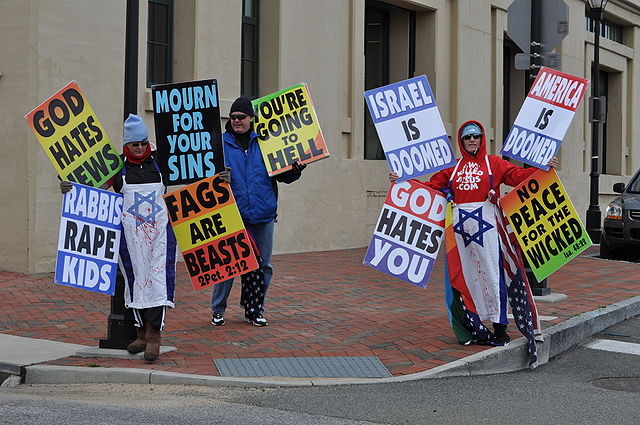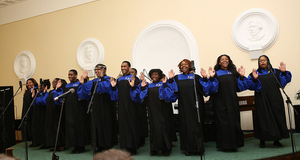Demagoguery and the Westboro Baptist Church: Deconstructing the Tactics of Hate
By
2014, Vol. 6 No. 02 | pg. 1/3 | »
IN THIS ARTICLE
KEYWORDS
The Westboro Baptist Church has become widely known for their hatred, polarizing statements, and funeral protests. Consisting of only a small family of about 40 members, Westboro has nevertheless become one of the most recognizable hate groups in the United States. Led by American pastor and ex-civil rights activist Fred Phelps, the Kansas church has been actively preaching messages of hate toward gays, non-Christians, Jews, and even celebrities since the early nineties. They have conquered news headlines for years with their abrasive tactics and offensive signs, but their widest and most long-lasting reach has been through cyberspace, where home videos of their protests and proud civilian counter-protests continue to gather attention. Today, YouTube and social media sites are crucial vessels used to spread the groups' demagogic messages of hate.
Westboro Baptist ChurchThe focus of the Westboro Baptist Church's (WBC's) hateful rhetoric has to do with religion. The church sticks to a strict, word-for-word interpretation of the Bible, believing anyone who does not follow its exact letter is doomed to an eternity of suffering in Hell. The WBC uses the term "fag" as a blanket term to refer to anyone they consider a sinner in the eyes of God. These "fags," which can include anyone from gays to criminals, are deemed as the outgroup, and are blamed for causing tragedies due to God's vengeance for our sins. Their slogan "God Hates Fags" is found on their website as well as printed on brightly colored signs that they wave at protests. More recently, Westboro seems to be targeting victims of more mainstream tragedies, claiming that their deaths are a result of God's punishment for our sins. Members can frequently be found protesting the funerals of victims, as well as soldiers, politicians, and celebrities. While these actions are often appalling and offensive, an analysis of the rhetoric of the Westboro Church shows us their powerful, effective tactics of persuasion and coercion.To this date, the Westboro Baptist Church is discussed online and seen in the news regularly. Much of their growing power has been rooted in emotional confrontations, and a self-sustaining online presence. As Westboro continues to use shocking, offensive tactics, the size of their online presence grows. Videos of their protests have been viewed millions of times, along with hundreds of videos of proud counter-protests. Regardless of how the videos are received, their message is still given a large platform in the digital age. DemagogueryPatricia Roberts-Miller (2008), author of "Democracy, Demagoguery, and Critical Rhetoric," defines demagoguery as "polarizing propaganda that motivates members of an ingroup to hate and scapegoat some outgroup" (p. 1). Users of this propaganda, or demagogues, execute calculated communication techniques to persuade their audience, often through fear or scapegoating, of their message. Demagogues, Miller argues, exemplify certain common characteristics, making them more identifiable. It is important to note why it is necessary to identify a demagogue by connecting it with these characteristics. The enemy of demagoguery is education. In order to prevent it, one must be able to identify it. Roberts-Miller (2008) even begins her essay by pointing out a need for a "renewed interest on the part of rhetoric teachers, theorists, and critics in the topic of demagoguery" (p.1). It is the goal of this essay to connect the Westboro Baptist Church's rhetorical techniques to the characteristics of demagoguery presented by Roberts-Miller, in order to point out the effectiveness of their techniques and to hopefully diminish their power. PolarizationThe key term in Robert's Miller's definition of demagoguery that fits the mission of the Westboro Church is "polarization." Roberts-Miller says that it is one of the most important qualities of demagoguery, and it is certainly Westboro's most powerful weapon. Polarization is essentially "black and white" thinking, where a diverse group is divided into two clear sides (Roberts-Miller, 2008). This idea is common in demagoguery and hate rhetoric, and it provides the audience with only two options. There are two groups, those who are right, and those who are evil, or the cause of pain and suffering. This term is key in analyzing Westboro's rhetoric, as it is the basic argument from which all other characteristics of their argument branch off. Roberts-Miller (2008) uses the terms "ingroup" and "outgroup" to describe these two sides of the argument, the outgroup being the target of the hateful rhetoric. The Westboro Church most prominently includes gays, Jews, and non-Christians as the outgroup. What makes this church unique, though, is that it appears that they do not want anyone to join their ingroup, but rather to simply have the outgroup suffer for their previous sins. They offer no salvation or solution other than pointing out God's vengeance and an explanation for it. Their website, godhatesfags.com, touts the following message: "We tell the truth. We aren't interested in persuading you to change -- that's God's business" (Godhatesfags.com, 2013). Therefore, it appears that the creation of this divide or polarization is the main goal of the church, making Westboro's purpose purely selfish. Apocalyptic MetanarrativeThe church's website provides the best insight into what Roberts-Miller refers to as the use of "God and Devil terms" and "Apocalyptic Metanarrative." When most people see or hear of the WBC, this characteristic of their rhetoric is most likely what they think of first. These characteristics go hand in hand, as the church preaches of an angry, vengeful God that will doom our souls to Hell and eventually bring the end of days. While this seems like a simple technique, it is Westboro's core message, and they attempt to use religion to back their argument. The backing of the Bible can be found frequently on their website, where they quote scripture and provide interpretations that claim God is angry. There is one section specifically called "God's Hatred in the Bible" that gives quotes from the Bible that attempt to prove God's wrath. One example demonstrates God's capability to hate: "Psalm 5:6 – 'Thou shalt destroy them that speak leasing: the LORD will abhor the bloody and deceitful man'" (Westboro, 2013). Surely these quotes are meant to achieve a sense of legitimacy and credit for their claims. Here, the speaker presumes the Bible to be understood as the trusted source, its credibility given through the almighty power of God. While this may not be the shared belief of the audience, it is the presumption that this is agreed upon that lends power to the message. Mostly, though, it appears that Westboro wants to show its audience examples of God's power, using fear of an apocalyptic event to persuade that their message is right. This point can be seen further through the messages painted across Westboro's infamous signs, carried during protests. Common phrases such as "God Hates America," "God's Wrath is Revealed," and "God Loves Dead Soldiers" are used in an effort to provoke a predicted reaction. These signs create an image of an angry, hateful God that punishes those who disobey the strict word of the Bible, as interpreted by the Westboro Church. With signs like "Plane Crash, God Laughs," the church is sending the message that the reason people die in tragic events is because God is punishing them. This point is driven even deeper when these signs celebrate God's anger at the funeral of a victim of tragedy, with grieving family and friends being forced to witness a group of people celebrating the death of their loved one.Continued on Next Page » Suggested Reading from Inquiries Journal
Inquiries Journal provides undergraduate and graduate students around the world a platform for the wide dissemination of academic work over a range of core disciplines. Representing the work of students from hundreds of institutions around the globe, Inquiries Journal's large database of academic articles is completely free. Learn more | Blog | Submit Latest in Business & Communications |

















